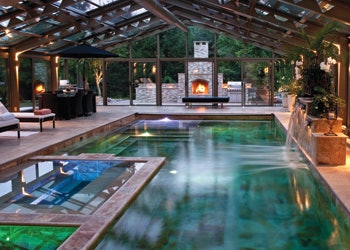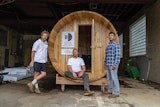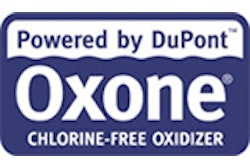
When Barry Justus, owner of Poolscape in Burlington, Ontario, first met with the homeowners, they mainly wanted to feel like they were outside when enjoying their indoor pool.
"The home is located in an area where black flies are a huge problem in the spring, making an outdoor pool impractical," says Justus. "As I looked around their home, it was obvious they were very much into nature. There were bird feeders all over the backyard — wildlife was plentiful. As our conversations continued, they commented on how they loved the outdoors, loved to swim laps and wanted a hot tub. I suggested combining the best of both indoor and outdoor pools."
What makes this both an indoor and outdoor pool is the aluminum-and-tempered-glass Open Aire enclosure. This Oakville, Ontario-based supplier custom made the structure, featuring a retractable roof that opens halfway during the warmer months of the year. A screen just below the roof keeps out the black flies, other bugs, leaves and dirt.

Since one of the biggest expenses of an indoor pool is controlling the humidity and air quality, one of the biggest advantages of this pool, says Justus, is that you can shut the HVAC system off when the roof is open. "And when the roof opens up, it's just like a chimney," he says. "So the hot air goes out through the roof, and the cold air gets sucked in through the side windows, creating a natural breeze. So it's quite pleasant in there even on a hot day."
When the HVAC system is running, it takes humidity out of the air, and in an effort to conserve water, that moisture gets pumped back into the pool. "About the only thing we didn't do that we could have done was capture rain water coming off the roof and cycle it back into the pool, but this pool loses hardly any water at all so we didn't do that," says Justus.
Green Scene
The energy savings from opening the retractable roof is one of the less-common eco-friendly features of this 18-by-44-foot pool, though it includes a number of more-familiar green pool components, as well.
It's got an automatic cover by Cover Pools, which, according to Justus, is absolutely crucial. "The main thing in any of these pools for efficiency is to cover them. If you don't put a cover on it, everything else is a waste of time because the chemicals and heat leave as water evaporates. You lose 70 percent of your heat right off the top of the pool, so putting a cover on the pool is No. 1 thing you can do to save energy, and then everything else you do is just a bonus."

These homeowners got quite a bonus because the project also has variable-drive pumps and a Jandy 32-zone automation system that cranks up the pump in the middle of the night to run the in-floor cleaning system. "So when the pump is costing more to run — when it's at a higher rpm — it's at a lower electrical cost," says Justus. "If the variable-drive pump only ran at 600 rpm — which is where these pumps run the majority of the time — in our area a pump like that could run for 24 hours a day for a month for $8. Now when you crank them up to full speed, they suck a lot more power."
This pool would certainly draw a bit more power if it weren't insulated as well as it is. Says Justus, "We insulated every available surface: the footings, the pool shell, the bunker walls, the bunker roof (more about this bunker soon), all of the plumbing and the building walls that are not glass. With its cover on, the pool is an insulated thermos."
The pool's bunker is a 1,200-square-foot and 8-foot-high underground room that goes all the way around the pool, underneath the deck.

Aside from its utilitarian value of housing all the pool equipment, plus a steam room and bathroom, the bunker also enhances the efficiency of the pool in a couple of different ways. "It separates the pool from the earth," says Justus, "and a couple feet underground, the earth's temperature is 55 degrees, so if you've got an indoor pool — they keep theirs at almost 90 degrees — you're constantly losing heat to the ground. On this pool, we've got a complete air barrier between the dirt and the pool wall so that makes it a lot easier for the pool to retain heat.
"The bunker also allows us to have extremely short plumbing runs," adds Justus. "The pumps are literally right beside the pool wall, so we could run a 4-inch line and we might only have 10 feet of plumbing with a couple elbows, if any. It's not only safer when you use bigger plumbing, you also get better circulation with fewer rpms on the pump. You're just not burning as much power to get the same effect, so that maximizes that efficiency."

In response to those who hesitate to specify larger plumbing because of the cost involved, Justus has found his clients are willing to pay for it as long as he explains the benefits: Less power is required, and it's much safer. "If you go in front of a main drain grate that's got big plumbing going off of it, there's no suction. You can't feel it; it's just spread out."
"We just finished another indoor pool," continues Justus, "and the owner said he dove down purposefully to see how much suction there was on the grate and he said he couldn't feel anything. That's because it's a big pipe drawing the water through and it's spread over a big grate — there's just nothing to get sucked up against."

Warmed From Below
Another less-common eco-friendly feature of this pool is its geothermal heating system. "The home was originally heated via propane, which is very expensive and inefficient," says Justus. "We installed a geothermal system to heat and cool the home as well as the indoor pool structure, the pool, hot spa and chill pool.
"For this particular project, we didn't have much room, so we had to drill straight down 250 feet, and then they put in a series of pipes that go into the ground. Those take the heat out of the earth and warm up the pool and house."
There's certainly a significant up-front expense to installing geothermal heat, but then energy costs are much, much lower forever, says Justus. "We're estimating six to eight years to get the cost back for this project. A lot of that is predicated on using the system properly, meaning they need to open the roof when it gets hot and run the cleaner in the middle of the night, etc."

To heat the center-deep pool evenly, Poolscape installed all of the return lines at the bottom of the pool, which is 4 feet deep at either end and 5 ½ feet at the center. So the hot water goes in at the bottom of the pool and then naturally rises to the top so you get good circulation from the convection currents.
Job Well Done
After an arduous eight-month-long design, engineering and planning process that involved multiple trips to the city building department to explain the numerous out-of-the-box features like the Open Aire building, the bunker, the integrated geothermal and the chill pool, which were all new for the building department, Justus was invited back to the home a few months after completing the project for a nighttime viewing. (Construction, by the way, took five months.)
"As I walked out of their kitchen and into the building there was an immediate sense of peace," says Justus. "I noticed the smell of the air, the falling water, the different lighting effects, music playing in the background, candles, the fireplace glowing in the outdoor patio. It was magical, and I could feel the stress of my normal day melting away. We had created a place for our clients to relax and get away from the world for a while. I am proud of the fact that we created an exceptionally environmentally friendly pool that is aesthetically pleasing and mechanically sound."
Comments or thoughts on this article? Please e-mail [email protected].











































